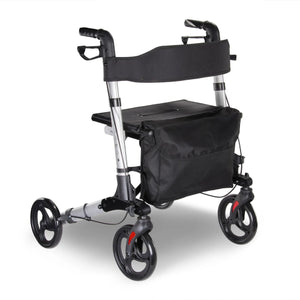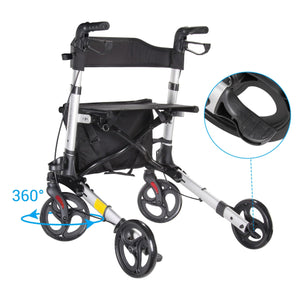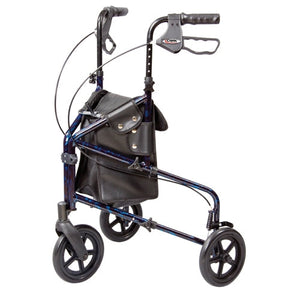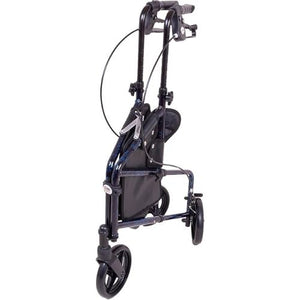Moving around can become increasingly difficult as we age. If you're over 80 and you fall and break a bone, you might need a cane forever. If you already use a cane, you might need a walker next. And if you need a walker, a wheelchair might be next, which could limit how you move and live.
If you're considering getting a walker but need to figure out what's out there, this guide will help you. Let’s discuss different types of walkers for older adults.
What Type of Equipment is a Walker?
A walker is a mobility device that helps people walk and retain their balance. It usually consists of a frame with legs and occasionally wheels.
Walkers aren't just for people with lasting injuries. They also give you extra support when you're moving around.
Their broader base helps you maintain your balance and reduces the risk of falls and accidents.
Even though you might think of a walker as something that slows you down or gets in the way of an active life, it improves your life, whether you need it for a little while or a long time.
The following are a few of the best kinds of walkers to be aware of:
1- Standard Walker
With a structure with four legs and no wheels, this walker type is the most basic. It offers support and stability to people who struggle to walk because of balance problems, leg weakness, or other mobility concerns.
Although the user must raise the walker with each step, they provide excellent stability.
2- Two-Wheel Walker
Like a standard walker, the two-wheel walker has four legs but features two small wheels on the front legs.
These wheels make it easier to move the walker forward and require less effort to lift, as the user only needs to push the walker rather than lift it entirely with each step.
3- Four-Wheeled Walker
Also known as rollators, four-wheeled walkers have wheels on all four legs, providing greater mobility and stability than standard walkers.
Usually, they have hand brakes that enable the user to regulate speed and securely stop.
Four-wheeled walkers have extra amenities, including a seat, backrest, and storage basket, and are appropriate for indoor and outdoor use.
4- Three-Wheeled Walker
Instead of having four wheels, this kind of walker has three—two in the back and one in the front.
Three-wheeled walkers offer increased maneuverability and can get through tight spaces and narrow doorways.
These provide support and stability for individuals who need assistance with walking but want a more agile and lightweight option than traditional four-wheeled walkers.
5- Knee Walker
A knee walker is a mobility aid used by individuals who have an injury or surgery on one leg and cannot bear weight.
It comprises a cushioned platform where the user can rest their wounded leg comfortably and use their other leg to move forward.
Knee walkers typically have handlebars for steering and brakes for stopping.
6- Rolling Walker
This term is often used interchangeably with four-wheeled walkers or rollators. Any walker with wheels on its four legs is considered a rolling walker.
These offer mobility assistance and support for individuals with mobility challenges.
Rolling walkers are versatile indoors and outdoors.
7- Upright Walker
To accommodate users of varying heights, upright walkers frequently feature an adjustable height setting and a lightweight frame.
It typically features ergonomic handles that allow the user to stand more upright, preventing them from hunching over the walker.
Upright walkers often have a lightweight frame and adjustable height settings to accommodate users of different heights.
They are great for maintaining a natural walking posture and reducing discomfort or fatigue.
8- Side-Step Walker
Also known as a hemi walker, a side-step walker provides support on one side of the body for individuals who need assistance with balance or mobility on one side.
It features a more petite frame than a standard walker and can be used primarily on the side opposite the affected limb.
Users using side-step walkers can move more freely and comfortably while receiving assistance and stability.
They are great for recovering from injuries or surgeries affecting one side of the body, such as hip or knee replacements.
9- Folding Walker
A folding walker is similar to a standard walker but with the added convenience of being foldable for easy storage and transportation.
It typically features hinges or mechanisms that allow the walker to collapse into a more compact size when not in use.
Folding walkers are practical for travel or individuals with limited home space.
Get a Custom Walker from MoovKart!
Are you looking for a reliable walker? Get one from MoovKart!
MoovKart walkers can provide the support you need for more effortless mobility.
Plus, they come in a variety of styles to suit your preferences.
Check out our collection of different types of walkers.
People Also Ask!
Are there different types of walkers?
Yes, there are different types of walkers, including standard walkers, rollators, knee walkers, and upright walkers.
What is the difference between walkers?
The difference between walkers lies in their design and features, such as the number of wheels, seats, or brakes, and ergonomic considerations.
What is the most popular walker?
Rollators, also known as four-wheeled walkers, are the most popular due to their versatility, providing indoor and outdoor mobility assistance.







